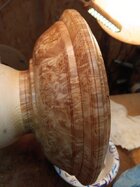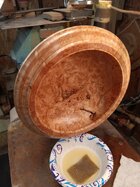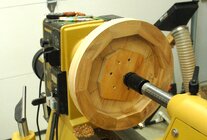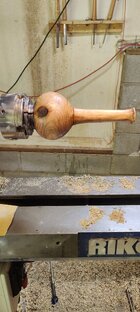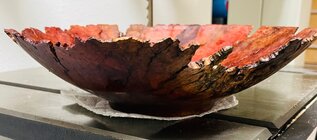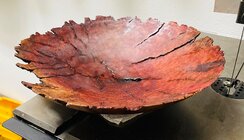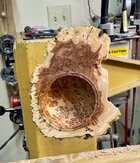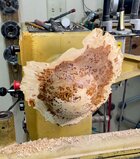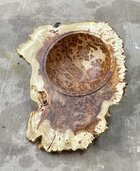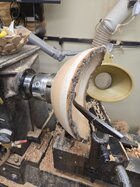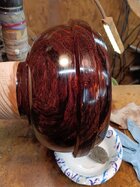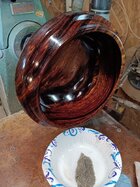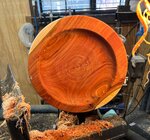-
December 2025 Turning Challenge: Single Tree! (click here for details) -
Congratulations to Bob Henrickson, People's Choice in the November 2025 Turning Challenge (click here for details) -
Congratulations to Guillaume Fontaine for "Old Tea Pot" being selected as Turning of the Week for December 15, 2025 (click here for details) -
Welcome new registering member. Your username must be your real First and Last name (for example: John Doe). "Screen names" and "handles" are not allowed and your registration will be deleted if you don't use your real name. Also, do not use all caps nor all lower case.
You are using an out of date browser. It may not display this or other websites correctly.
You should upgrade or use an alternative browser.
You should upgrade or use an alternative browser.
What’s on your lathe?
- Thread starter Rusty Nesmith
- Start date
Now you’re on a roll!
Beautiful, almost looks like a piece of marble.
Working with some birch for this months challenge. Hope I don't drop it...
Another stunning bowl. I really like the way you do undercut the rim.
Bob
Finished turning the maple tonight and put a coat of DO on it to try and slow the drying since it was a very wet piece, measures 9-3/4 x 8. May carve some on it once my micro gets here as of now it’s taking a tour of the US thanks to USPS putting it on the wrong truck! It was 3 hours away and it looks like it will take two weeks to get to me!
View attachment 75384
That wood is mind blowing... Ambrosia?
A piece of holly, originally about 6" in diameter, lost some of that due to extreme warping (bought as a heavily waxed green piece about three years ago.) Recessed foot, mortised into the chuck, which will likely require a bit of cleanup. A small catch while turning the inside required making the walls a bit thinner than I intended...but not too much.
Not yet sure what to do for a finish...I really like the neutral color here, and I am not a fan of high solids water based finishes (they have no penetration and don't bring out the chatoyance like oil based finishes do.) But most oil based or even shellac finishes will yellow this....and I feel I'll lose something unique if I do that. There are some very subtle bits of staining as well...a grayish color but barely differentiated from the near paper-white, and I fear I might lose those nuances entirely with an oil based finish.
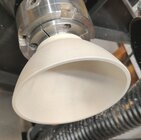
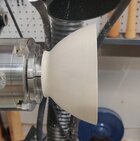
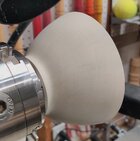
Not yet sure what to do for a finish...I really like the neutral color here, and I am not a fan of high solids water based finishes (they have no penetration and don't bring out the chatoyance like oil based finishes do.) But most oil based or even shellac finishes will yellow this....and I feel I'll lose something unique if I do that. There are some very subtle bits of staining as well...a grayish color but barely differentiated from the near paper-white, and I fear I might lose those nuances entirely with an oil based finish.



Yes, ambrosia. I am fortunate to have a couple logs and hoping the rest looks this good.That wood is mind blowing... Ambrosia?
Not yet sure what to do for a finish...I really like the neutral color here, and I am not a fan of high solids water based finishes (they have no penetration and don't bring out the chatoyance like oil based finishes do.) But most oil based or even shellac finishes will yellow this....and I feel I'll lose something unique if I do that.
Here's something to consider: Platinum Blonde Shellac. It will change the color very little. Here's a pic I did on hard maple. I set it out in the sun to better show the difference, To the left of the blue line, the wood is bare...to the right is the platinum blonde shellac.
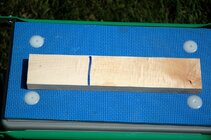
The holly piece takes me back. I got a tree once that was "over 100 years old". The wood had the most lovely green colors running through it. I have never seen anything like it since. I don't like the trees, except when they are in some one else's yard.... Those leaves are not for bare footing....
robo hippy
robo hippy
Here's something to consider: Platinum Blonde Shellac. It will change the color very little. Here's a pic I did on hard maple. I set it out in the sun to better show the difference, To the left of the blue line, the wood is bare...to the right is the platinum blonde shellac.View attachment 75656
Thanks! I'll have to see if I can find some plat-blond flakes and try this.
I have beehives here, and bees love holly trees. When the flowers are blooming I can hear the bees 50' away from the biggest holly.The holly piece takes me back. ...I don't like the trees, except when they are in some one else's yard....
Trees cut in the dead of winter will have pure white wood if dried aggressively. Holly trees cut in the late spring or summer will often turn an ugly grey from fungus. The fineness of the grain, of course, doesn't change so a 2-part bleach is said to make it white again. I like to use holly for finials, "magic" wands, conductor baton shafts, finger tops, and handbell ornaments. If careful it can be cut so cleanly it doesn't need sanding. I think I sanded and buffed the one from ebony but the holly is straight off the tool.
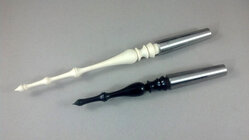
Due the the very fine grain, a friend used holly a lot on his rose engine.
JKJ
Tom Gall
TOTW Team
It's been about 3 decades since I had a piece of snow-white Holly large enough to make a bowl. As I recall, I used a water-based finish then sanded back with #0000 steel wool or white fiber abrasive pad, and then Beall buffed it. It looked like porcelain. But, maybe you want it to look like wood.Not yet sure what to do for a finish...I really like the neutral color here, and I am not a fan of high solids water based finishes (they have no penetration and don't bring out the chatoyance like oil based finishes do.)
On smaller Holly pieces (i.e., ornament finials) I use a piece/shard of hard carnauba wax and apply it to the spinning piece (high speed) and then buff with a small piece of paper towel. I don't know if that process would work as well on a bowl - but it should.
BTW- I don't believe I've ever had any Holly with a lot of chatoyance.
It's been about 3 decades since I had a piece of snow-white Holly large enough to make a bowl. As I recall, I used a water-based finish then sanded back with #0000 steel wool or white fiber abrasive pad, and then Beall buffed it. It looked like porcelain. But, maybe you want it to look like wood.
On smaller Holly pieces (i.e., ornament finials) I use a piece/shard of hard carnauba wax and apply it to the spinning piece (high speed) and then buff with a small piece of paper towel. I don't know if that process would work as well on a bowl - but it should.
BTW- I don't believe I've ever had any Holly with a lot of chatoyance.
I don't want to derail the thread more...I'll start a thread on finishing very light woods, maybe we can continue there.
Just took a very challenging piece off lathe. A manzanita burl with cracks and defects. Should have wrapped it because I lost some and had to make it w less height. Still ok. A little more work needed, though. 12 inch diameter. Will take better pictures when it’s done.
Attachments
Last edited:
Odie
Panning for Montana gold, with Betsy, the mule!
A piece of holly, originally about 6" in diameter, lost some of that due to extreme warping (bought as a heavily waxed green piece about three years ago.) Recessed foot, mortised into the chuck, which will likely require a bit of cleanup. A small catch while turning the inside required making the walls a bit thinner than I intended...but not too much.
Not yet sure what to do for a finish...I really like the neutral color here, and I am not a fan of high solids water based finishes (they have no penetration and don't bring out the chatoyance like oil based finishes do.) But most oil based or even shellac finishes will yellow this....and I feel I'll lose something unique if I do that. There are some very subtle bits of staining as well...a grayish color but barely differentiated from the near paper-white, and I fear I might lose those nuances entirely with an oil based finish.
Over the years, the question of how to maintain the color of white woods comes up occasionally, and I don't think there has ever been a good solution to this.
Possibly eliminating the finish and go directly to the buffing and wax might be helpful......I tried that once and was not happy with the results. The oil finish is better....but, as you know.....it "yellows" that great white coloring.
=o=
Over the years, the question of how to maintain the color of white woods comes up occasionally, and I don't think there has ever been a good solution to this.
Possibly eliminating the finish and go directly to the buffing and wax might be helpful......I tried that once and was not happy with the results. The oil finish is better....but, as you know.....it "yellows" that great white coloring.
=o=
Yeah, I considered skipping a finish, but I decided I wouldn't do that. I think this beautiful wood would just end up grimy and nasty in relatively short order if I did.
I picked up some super blond shellac, and may get something even more translucent as well: Platina shellac. The platina might do the trick...not sure yet. I'll share my results. I started another thread on the topic of keeping very light colored/whitish/white woods their natural color, and I'll share the results over there.
It may also be that lacquer can do the trick. I am spending a couple of days here, really learning how to apply a lacquer finish, as I've never quite figured it out in the past. Burning through a couple cans of lacquer here, but, I think I've figured it out now.
Wow James! That is stunning.A small winged elm burl bowl, turned green to finished size. I sanded and dried it a bit with a few short cycles in the microwave, then soaked with Danish oil.
View attachment 75706
I used a vacuum chuck to finish the bottom.
View attachment 75707View attachment 75708
- Joined
- Nov 27, 2021
- Messages
- 241
- Likes
- 999
- Location
- Silver Spring, MD
- Website
- www.transpirationturning.com
It’s been a busy time, but soon I’ll get back to the lathe… first-ever art exhibit installed this past Sunday. If anyone is local and might stop in to see it let me know and I’d enjoy meeting you there to put a face to a name…
Newark Arts Alliance
Newark Arts Alliance
Attachments
Odie
Panning for Montana gold, with Betsy, the mule!
A small winged elm burl bowl, turned green to finished size. I sanded and dried it a bit with a few short cycles in the microwave, then soaked with Danish oil.
View attachment 75706
I used a vacuum chuck to finish the bottom.
View attachment 75707View attachment 75708
How well does a vacuum chuck hold something so out of balance as this?
Odie
Panning for Montana gold, with Betsy, the mule!
In this case it held very well. I wasn't sure if the burl would be too porous to get a good vacuum, but it did. The size of the chuck made it almost a jam chuck and I always leave the tailstock up until I remove the nub on the bottom.How well does a vacuum chuck hold something so out of balance as this?
WOW...Been working the last two evenings on this Cocobolo bowl.....some pretty tough turning!
Still very wet from application of DO......
=o=
View attachment 75753 View attachment 75754
Been working the last two evenings on this Cocobolo bowl.....some pretty tough turning!
Still very wet from application of DO......
=o=
View attachment 75753 View attachment 75754
Beautiful bowl!!
Have you had good results from DO on Cocobolo?
I ask because I once used the oil on a small piece made from Cocobolo and in a few months all the wonderful color had darkened to almost black.
I think (at least some) Cocobolo naturally turns very dark from either oxygen in the air or light. I have two large pieces of the wood, both almost too heavy to lift, and considering the source are probably at least 100 years old. Both have darkened a little on the outside surfaces but one is almost black for maybe 3/8” from the outsides, evident when I cut off a chunk. Since then, I’ve been applying shellac or shellac-based friction polish to turnings. Those seem to have kept their color for years now.
BTW, I LOVE turning Cocobolo - leaves a surface almost as smooth as glass! Smells good too. If you ever get bored with turning it I'll send you my address.
So far I haven’t become sensitive to the wood, although I do wear a respirator and wash up well after sanding. I mostly make smaller things, like finger tops, "magic" wands, conductor baton handles, pepper mills, and lidded boxes.
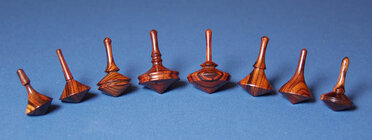
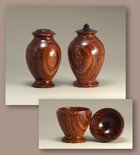
And from the Fidgit Spinner craze: Cocobolo, Ebony, brass
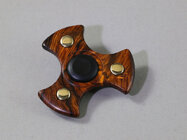
JKJ
Wow, just pages of beautiful work here to ooh and ahh and get inspired over. My tree-man neighbor texted me pics from a job site just across the creek Wednesday, so of course I had to go get some maple, all about 13-14" in diameter. I started with this one yesterday, ending up with a 13x6x.5" live edge with a little bit of ambrosia. Still some pretty grain that was a different color every time I looked at it yesterday as it oxidized and changed color-I love turning green maple! I sanded out the tool-marks and tear-out the best I could before my back gave out lol. So I just sealed it with shellac, applied thin ca around the bark line, and in the bag with shavings for awhile. That oversized base cut gives me design options after it dries; this one might get an "emerging" foot ring. I'll probably try my latest regimen with thinned TT Danish Oil followed by Varnish Oil and lots of rubbing out excess/burnishing at each step.

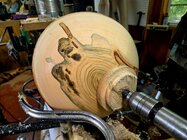
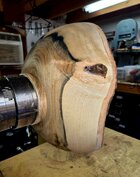
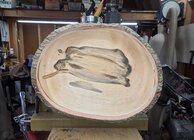




Beautiful work with coco, John-It's one of my favorite woods for a fancy shaving brush with a nice badger knot. Love those tops and that perfect lidded box!Beautiful bowl!!
Have you had good results from DO on Cocobolo?
I ask because I once used the oil on a small piece made from Cocobolo and in a few months all the wonderful color had darkened to almost black.
I think (at least some) Cocobolo naturally turns very dark from either oxygen in the air or light. I have two large pieces of the wood, both almost too heavy to lift, and considering the source are probably at least 100 years old. Both have darkened a little on the outside surfaces but one is almost black for maybe 3/8” from the outsides, evident when I cut off a chunk. Since then, I’ve been applying shellac or shellac-based friction polish to turnings. Those seem to have kept their color for years now.
BTW, I LOVE turning Cocobolo - leaves a surface almost as smooth as glass! Smells good too. If you ever get bored with turning it I'll send you my address.
So far I haven’t become sensitive to the wood, although I do wear a respirator and wash up well after sanding. I mostly make smaller things, like finger tops, "magic" wands, conductor baton handles, pepper mills, and lidded boxes.
View attachment 75755
View attachment 75756
And from the Fidgit Spinner craze: Cocobolo, Ebony, brass
View attachment 75757
JKJ
Odie
Panning for Montana gold, with Betsy, the mule!
Have you had good results from DO on Cocobolo?
I ask because I once used the oil on a small piece made from Cocobolo and in a few months all the wonderful color had darkened to almost black.
I think (at least some) Cocobolo naturally turns very dark from either oxygen in the air or light. I have two large pieces of the wood, both almost too heavy to lift, and considering the source are probably at least 100 years old. Both have darkened a little on the outside surfaces but one is almost black for maybe 3/8” from the outsides, evident when I cut off a chunk. Since then, I’ve been applying shellac or shellac-based friction polish to turnings. Those seem to have kept their color for years now.
Nice work, John......
Well, I'm hoping it won't darken, but honestly, even though I've done probably a dozen Cocobolo bowls in the past.....all of them have sold before any darkening was apparent to me. If they have darkened, I am not aware that they have. No unhappy customers that I know of anyway!
From what I understand, it's the UV from sunlight that darkens the color in woods. So.....it will all depend on where the bowl is displayed.
This one was a bit tough to turn because I was having trouble "turning the corner" of the deep inward slanting wall. Because of that, I couldn't get the tool rest very close and there was more of an "overhang" than I'd have liked. The other surfaces weren't all that bad, but you do have to be really attentive to the sharpness of the tool.
One thing for sure, is the DO does not absorb into Cocobolo very well. It might be the tight grain, or a naturally oily content of the wood. Regardless, and as you have noticed, the final polished surface is extremely nice because of it.
=o=
Odie-I'm pretty sure it's the same issue that makes it hard to get a good glue joint, its natural oils. I gave up trying to oil finish any of the dhalbergias-they look best when finished to a high gloss with some friction polish culminating in a final friction polish using its own oils. Of course you have to keep it moving and watch out for heat checking. Sometimes I will run one through the Beall buffs or finish with Renaissance Wax buffing.Nice work, John......
Well, I'm hoping it won't darken, but honestly, even though I've done probably a dozen Cocobolo bowls in the past.....all of them have sold before any darkening was apparent to me. If they have darkened, I am not aware that they have. No unhappy customers that I know of anyway!
From what I understand, it's the UV from sunlight that darkens the color in woods. So.....it will all depend on where the bowl is displayed.
This one was a bit tough to turn because I was having trouble "turning the corner" of the deep inward slanting wall. Because of that, I couldn't get the tool rest very close and there was more of an "overhang" than I'd have liked. The other surfaces weren't all that bad, but you do have to be really attentive to the sharpness of the tool.
One thing for sure, is the DO does not absorb into Cocobolo very well. It might be the tight grain, or a naturally oily content of the wood. Regardless, and as you have noticed, the final polished surface is extremely nice because of it.
=o=
Very nice Odie!!Been working the last two evenings on this Cocobolo bowl.....some pretty tough turning!
Still very wet from application of DO......
=o=
View attachment 75753 View attachment 75754
Spill the beans - Where would you find a blank like that? I swear I hear Rod Stewart singing do you think I’m sexy.Been working the last two evenings on this Cocobolo bowl.....some pretty tough turning!
Still very wet from application of DO......
=o=
View attachment 75753 View attachment 75754
Thanks. Good fun.Nice work, John......
Well, I'm hoping it won't darken, but honestly, even though I've done probably a dozen Cocobolo bowls in the past.....all of them have sold before any darkening was apparent to me. If they have darkened, I am not aware that they have. No unhappy customers that I know of anyway!
From what I understand, it's the UV from sunlight that darkens the color in woods. So.....it will all depend on where the bowl is displayed.
This one was a bit tough to turn because I was having trouble "turning the corner" of the deep inward slanting wall. Because of that, I couldn't get the tool rest very close and there was more of an "overhang" than I'd have liked. The other surfaces weren't all that bad, but you do have to be really attentive to the sharpness of the tool.
One thing for sure, is the DO does not absorb into Cocobolo very well. It might be the tight grain, or a naturally oily content of the wood. Regardless, and as you have noticed, the final polished surface is extremely nice because of it.
=o=
As for cocobolo darkening, the small turning that tuned almost black after coating with “danish” oil was kept in an open container on a shelf in my display cabinet in my mostly darkened shop office. Not much UV there.
The big blocks of cocobolo were part of a large haul from an elderly gentleman. Don’t know the entire history, but I was led to believe the wood was in a garage for many decades. This, plus the depth of the darkened wood made me believe the darkening from the surface inwards was more likely due to oxidation - I can’t imagine light penetrating 3/8” deep into the surface. All brightly colored pieces I turned and sealed with shellac didn’t darken (that I could see) even after 10 or more years - maybe shellac stops both UV and oxidation?
I did some tests once, not on cocobolo, but on purpleheart which often goes to brown rather quickly. I left some blocks undisturbed on a shelf in a mostly darkened garage for months. And put others on a windowsill in the kitchen. Both lost color on exposed surfaces, retained it on the surfaces not exposed to light, leaving me with the unscientific observation that both light and oxidation may play a part.
The whole subject might benefit from careful decades-long testing, a good project for some young person. This article might be interesting:
Preventing Color Changes in Exotic Woods | The Wood Database
Oh, for any purpleheart fans out there, I once acquired purpleheart reportedly grown in Mexico - that stuff simply refuses to lose color even in the boards on the shelves or standing leaning against a wall. This suggests not all purpleheart is created equally. Perhaps the same is true for many other species.
JKJ
Odie
Panning for Montana gold, with Betsy, the mule!
Spill the beans - Where would you find a blank like that? I swear I hear Rod Stewart singing do you think I’m sexy.
I bought that one from an individual from Arizona on eBay for $200......
If you're interested, I can look up his account and let you know.....I believe he probably has more.
=o=
Odie
Panning for Montana gold, with Betsy, the mule!
I've heard the wholesale harvesting of South American exotic woods has been pretty much stopped.....as it should be.
Let's face it though.....trees are living things that die and can be harvested. Also, sometimes exotics are harvested for road construction and at other times when they interfere with building construction, and a few other reasons.
It's not like it was 50 years ago when the rainforest was being destroyed for these woods.
Exotics are available on a very limited basis......but, you have to pay the price for the best pieces that come to market!
=o=
Let's face it though.....trees are living things that die and can be harvested. Also, sometimes exotics are harvested for road construction and at other times when they interfere with building construction, and a few other reasons.
It's not like it was 50 years ago when the rainforest was being destroyed for these woods.
Exotics are available on a very limited basis......but, you have to pay the price for the best pieces that come to market!
=o=
Last edited:
Beautiful work with coco, John-It's one of my favorite woods for a fancy shaving brush with a nice badger knot. Love those tops and that perfect lidded box!
Thank you. I was offered good money for one of those boxes but I’d rather give them away. I gave one with a similar design to the mother with a new baby girl. I figured maybe she could use it for diaper pins at first, then the girl could save bugs or something in it later, then eventually jewelry.
That's one of my favorite lidded box designs and have made variations from a number of species - I like to make the inside egg-shaped. (I can't remember the last time I made a lidded box with a flat bottom inside - well, I just checked, made some in 2008)
This one from African Blackwood, another Dalbergia, is shaped a bit differently outside but still has the kind of egg-shaped interior.
Made this from one of those clarinet bell blanks.
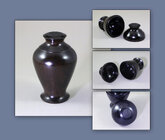
Looking at these makes me want to make another one - I have a nice piece of Kingwood, another rosewood, that's been begging for attention.
I'd also like to find a chunk of Brazilian Tulipwood that size.
JKJ
Recent storms took the top out of a cherry on the ranch. Only 20’ of trunk left. Started processing them today.
Ooo, cherry is great! That will prob look spectacular.
JKJ

